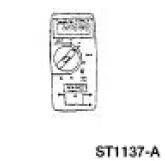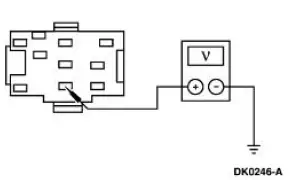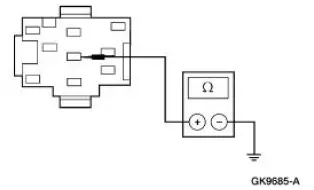Ford Mustang (1999-2004) Service Manual: Parking, Rear and License Lamps
Refer to Wiring Diagrams Cell 92 , Exterior for schematic and connector information.
Special Tool(s)
 |
73 III Automotive Meter or equivalent 105-R0057 |
Inspection and Verification
1. Verify the customer concern by operating the parking lamps.
2. Visually inspect for the following obvious signs of mechanical and electrical damage.
Visual Inspection Chart
| Mechanical |
Electrical |
|
|
3. If the concern is not visually evident, determine the symptom and proceed to Symptom Chart.
Symptom Chart
| Condition | Possible Sources | Action |
|
|
|
|
|
|
|
|
|
Pinpoint Tests
PINPOINT TEST L: THE PARKING, REAR OR LICENSE LAMPS ARE INOPERATIVE
| Test Step | Result / Action to Take |
| L1 CHECK THE VOLTAGE TO THE HEADLAMP SWITCH | Yes GO to L2 . No REPAIR the circuit. TEST the system for normal operation. |
|
|
| L2 CHECK CIRCUIT 14 (BN) FOR OPEN | Yes INSTALL a new headlamp switch; REFER to Lamp Switch-Headlamp . TEST the system for normal operation. No REPAIR the circuit. TEST the system for normal operation. |
|
PINPOINT TEST M: ONE OR MORE PARKING, REAR OR LICENSE LAMP(S) IS INOPERATIVE
| Test Step | Result / Action to Take |
| M1 CHECK THE VOLTAGE TO THE INOPERATIVE LAMP(S) | Yes REPAIR Circuit 1205 (BK) for an open. TEST the system for normal operation. No REPAIR the circuit. TEST the system for normal operation |
|
PINPOINT TEST N: THE PARKING, REAR OR LICENSE LAMPS ARE ON CONTINUOUSLY
| Test Step | Result / Action to Take |
| N1 CHECK THE HEADLAMP SWITCH | Yes REPAIR Circuit 14 (BN) for a short to battery. TEST the system for normal operation. No INSTALL a new headlamp switch; REFER to Lamp Switch-Headlamp . TEST the system for normal operation |
|
 Turn Signal and Hazard Lamps
Turn Signal and Hazard Lamps
Refer to Wiring Diagrams Cell 90 , Turn/Stop/Hazard Lamps for schematic
and connector information.
Special Tool(s)
73 III Automotive Meter
105-R0057 or equivalent
Inspection and Ver ...
 Fog Lamps
Fog Lamps
Refer to Wiring Diagrams Cell 86 , Fog Lamps for schematic and connector
information.
Special Tool(s)
73 III Automotive Meter or
equivalent
105-R0057
Principles of Operation
The f ...
Other materials:
Installation
NOTE: Do not use a fiber disc to clean the surfaces. Fibers from
the disc can get into the oil pan and
oil and clog the oil bypass valve.
1. Clean and inspect the cylinder head for flatness.
2. Install a new head gasket on the cylinder block with the sm ...
Assembly
1. CAUTION: Before beginning assembly, carry out and inspect the
following:
When building up subassemblies and assembling the transmission, ALWAYS use new
gaskets and seals.
All fasteners must be tightened to the torque specification indicated. In
addition ...
Jump-starting the vehicle
WARNING: The gases around the battery can explode if exposed
to flames, sparks, or lit cigarettes. An explosion could result in
injury or vehicle damage.
WARNING: Batteries contain sulfuric acid which can burn skin,
eyes and clothing, if contacted.
Do not atte ...


